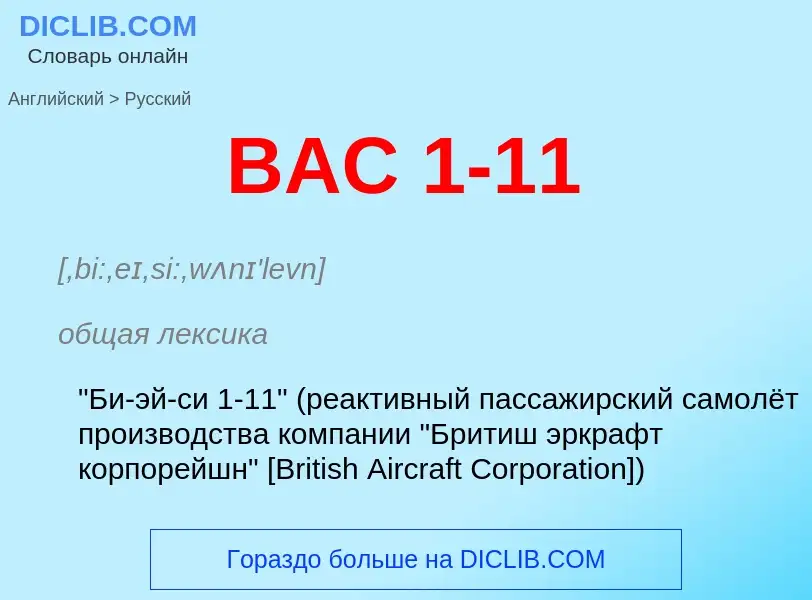Traducción y análisis de palabras por inteligencia artificial ChatGPT
En esta página puede obtener un análisis detallado de una palabra o frase, producido utilizando la mejor tecnología de inteligencia artificial hasta la fecha:
- cómo se usa la palabra
- frecuencia de uso
- se utiliza con más frecuencia en el habla oral o escrita
- opciones de traducción
- ejemplos de uso (varias frases con traducción)
- etimología
BAC 1-11 - traducción al Inglés
[,bi:,eɪ,si:,wʌnɪ'levn]
общая лексика
"Би-эй-си 1-11" (реактивный пассажирский самолёт производства компании "Бритиш эркрафт корпорейшн" [British Aircraft Corporation])
синоним
[,wʌnɪ'levn]
разговорное выражение
"сто одиннадцатый" (то же, что ВАС 1-11)
[,bi:,eɪ'si:]
сокращение
от British Aircraft Corporation
Definición
Wikipedia
.jpg?width=120)
The BAC One-Eleven (or BAC-111/BAC 1-11) was an early jet airliner produced by the British Aircraft Corporation (BAC). Originally conceived by Hunting Aircraft as a 30-seat jet, before its merger into BAC in 1960, it was launched as an 80-seat airliner with a British United Airways order on 9 May 1961. The prototype conducted its maiden flight on 20 August 1963, and it was first delivered to its launch customer on 22 January 1965. The 119-seat, stretched 500 series was introduced in 1967. Total production amounted to 244 until 1982 in the United Kingdom and between 1982 and 1989 in Romania where nine Rombac One-Eleven were licence-built by Romaero.
The short haul, narrowbody aircraft was powered by aft-mounted Rolls-Royce Spey low-bypass turbofans, a configuration similar to the earlier Sud Aviation Caravelle and later Douglas DC-9. It also competed with early Boeing 737 variants and was used by several US carriers, as well as multiple British, overseas and European airlines, including Romanian operators. It was replaced by the newer Airbus A320 and later 737 variants, as well as by the Bombardier CRJ200 regional jet. Noise restrictions accelerated its transition to African carriers in the 1990s, and the last BAC One-Eleven was retired in 2019.

.jpg?width=200)
![One-Eleven 510ED ''County of Dorset'' on display at the [[Imperial War Museum Duxford]] One-Eleven 510ED ''County of Dorset'' on display at the [[Imperial War Museum Duxford]]](https://commons.wikimedia.org/wiki/Special:FilePath/BAC 111-510ED 'G-AVMU' (24980480106).jpg?width=200)
![The 510ED cockpit, similar to the [[Hawker Siddeley Trident]] The 510ED cockpit, similar to the [[Hawker Siddeley Trident]]](https://commons.wikimedia.org/wiki/Special:FilePath/BAC 111-510ED One-Eleven, AB Airlines (European Aircharter - EAL) AN0528338.jpg?width=200)
![The BAC X-Eleven would have been stretched for up to 160 seats and powered by larger [[CFM56]] or [[JT10D]] turbofans The BAC X-Eleven would have been stretched for up to 160 seats and powered by larger [[CFM56]] or [[JT10D]] turbofans](https://commons.wikimedia.org/wiki/Special:FilePath/BAC X-Eleven.jpg?width=200)
![ft}} long to accommodate up to 89 seats with a single [[overwing exit]] per side ft}} long to accommodate up to 89 seats with a single [[overwing exit]] per side](https://commons.wikimedia.org/wiki/Special:FilePath/British Aerospace BAC One Eleven British Airways G-BBME, DUS Düsseldorf (Duesseldorf International), Germany PP1361872924.jpg?width=200)
![The last aircraft in service, used by [[Northrop Grumman]] as an airborne testbed, was retired in 2019 The last aircraft in service, used by [[Northrop Grumman]] as an airborne testbed, was retired in 2019](https://commons.wikimedia.org/wiki/Special:FilePath/British Aircraft Corporation BAC 1-11 Series 401AK, Northrop Grumman JP5644332.jpg?width=200)
 JP6105232.jpg?width=200)

![The first delivery was to [[British United Airways]] on 22 January 1965 The first delivery was to [[British United Airways]] on 22 January 1965](https://commons.wikimedia.org/wiki/Special:FilePath/G-ASJI 1 One-Eleven 201 British United LGW 14MAY66 (6785552209).jpg?width=200)
![The initial Hunting 107 concept from [[Hunting Aircraft]] The initial Hunting 107 concept from [[Hunting Aircraft]]](https://commons.wikimedia.org/wiki/Special:FilePath/Hunting 107.png?width=200)
![Several [[American Airlines]] BAC 1–11 at [[LaGuardia Airport]] Several [[American Airlines]] BAC 1–11 at [[LaGuardia Airport]]](https://commons.wikimedia.org/wiki/Special:FilePath/Line-up of American Airlines BAC 111-401AK One-Eleven at LaGuardia Airport.jpg?width=200)
![Five-abreast cabin, [[National Museum of Flight]] Five-abreast cabin, [[National Museum of Flight]]](https://commons.wikimedia.org/wiki/Special:FilePath/Main cabin of BAC One-Eleven 510ED ‘G-AVMO’ (25913063348).jpg?width=200)
![The first Rombac 1-11 was delivered to [[TAROM]] on 29 December 1982 The first Rombac 1-11 was delivered to [[TAROM]] on 29 December 1982](https://commons.wikimedia.org/wiki/Special:FilePath/ROMBAC 1-11 (YR-BRA).jpg?width=200)
![The selected [[Rolls-Royce Spey]] low-bypass [[turbofan]] The selected [[Rolls-Royce Spey]] low-bypass [[turbofan]]](https://commons.wikimedia.org/wiki/Special:FilePath/RR Spey.jpg?width=200)
![A [[Ryanair]] One-Eleven A [[Ryanair]] One-Eleven](https://commons.wikimedia.org/wiki/Special:FilePath/Ryanair Bucuresti Rombac 1-11-561RC One-Eleven Haafke-1.jpg?width=200)
